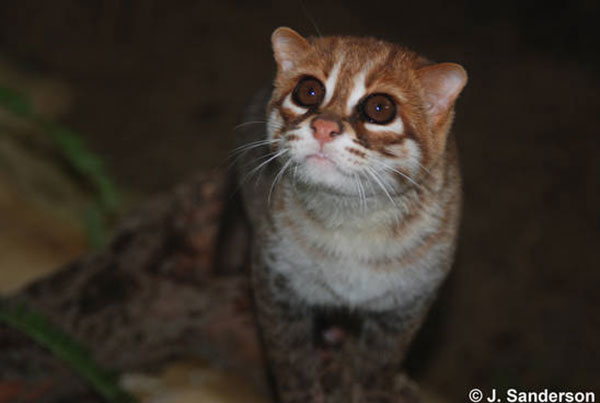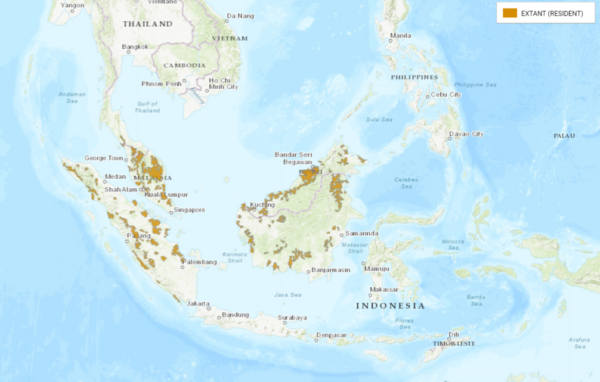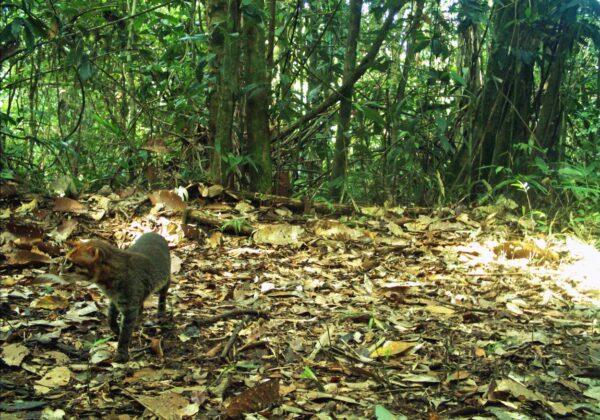
Flat Headed Cat: The Unique Characteristics
Flat Headed Cat Identification
The flat-headed cat (Prionailurus planiceps) is a small wild cat species native to Southeast Asia, known for its distinctive physical characteristics. The photo above was taken by Jim Sanderson, a small cat hero! Sanderson is the founder and director of the Small Wild Cat Conservation Foundation, a member of the IUCN Cat Specialist Group, a review board member of the Mohamed bin Zayed Species Conservation Fund, and a fellow of Wildlife Conservation Network. Sanderson’s mission is to ensure the survival of small wild cats and their natural habitats worldwide. I am fortunate to have heard Jim Sanderson speak twice. Both times I felt uplifted and hopeful about the future of small wild cats.
Flat-Headed Cat Physical Characteristics
The flat-headed cat has a unique appearance, with a head resembling a domestic cat but with a flattened forehead that gives the cat their name. Their fur varies in color, with a reddish coat on the upper body and a white underbelly, chest, and lower part of the face. The fur on the body is often mottled white, giving the cat a striking appearance.
The cat has rounded ears and short legs, making them appear smaller than they are. The cat is comparable in size to a domestic cat, with a length ranging from approximately 41-50cm and a weight of about 1.5-2.5kg. Despite their small stature, the flat-headed cat has a disproportionately short tail, measuring only about 14-20cm.
The eyes of the flat-headed cat are striking, with a reflective quality that aids in night vision. Additionally, the cat’s paws are uniquely adapted for their aquatic lifestyle, with partially webbed feet that make them an excellent swimmer.
Taxonomy and Classification
The flat-headed cat is classified within the family Felidae, and the order Carnivora, under the class Mammalia. The genus Prionailurus, which the flat-headed cat falls under, also includes other Asian small cats such as the fishing cat (Prionailurus viverrinus) and the leopard cat (Prionailurus bengalensis).
Within the Felidae family, the flat-headed cat shares a close phylogenetic relationship with the fishing cat and the leopard cat. The Felidae family is further divided into two subfamilies: Pantherinae (which includes big cats like lions and tigers) and Felinae (which features smaller cats). The flat-headed cat belongs to the Felinae subfamily, along with other smaller felids such as the domestic cat (Felis catus).
Morphologically, the flat-headed cat is distinct from other members of its genus and the Felidae family, primarily due to its noticeably flattened skull and short, broad face. These features make it unique among small cats and have led some researchers to propose that the intraspecific taxonomy of the flat-headed cat should be reassessed to better understand its genetic distinctiveness.
Despite its fascinating appearance and unique characteristics, the flat-headed cat remains underrepresented and under-researched in scientific studies, with the majority of research efforts being directed toward more well-known felids. Nonetheless, it is imperative to gain a deeper understanding of the flat-headed cat’s taxonomy, classification, and overall genetics to inform and support effective conservation efforts for this endangered species. The flat-headed cat can serve as a flagship species for the protection of the rich biodiversity found in its native habitats throughout Southeast Asia.
Habitat and Distribution

Geographic Range
The Flat-Headed Cat is primarily found in Southeast Asia, including Malaysia, Thailand, Sumatra, and Borneo. Historically, this rare cat’s distribution likely encompassed suitable habitats across the region. Currently, its presence has been recorded in Southern Thailand, Indonesia, and Peninsular Malaysia. However, due to habitat loss and fragmentation, the Flat-Headed Cat’s range has been reduced, and the species now faces an uncertain future.
Habitat Preferences
Flat-Headed Cats inhabit a variety of habitats within their range, primarily focusing on lowland areas near water sources. These cats have a strong affinity for forests, rainforests, and secondary forests. Wetland areas, such as rivers, streams, and lakes, are particularly important for the Flat-Headed Cat, as they rely on these resources for food and cover.
Additionally, they have been observed utilizing plantations, including oil palm plantations, as part of their territory. However, these cultivated areas often result in habitat loss and degradation, threatening the cat’s long-term survival.
Overall, the Flat-Headed Cat’s habitat preferences and distribution are closely linked to their need for water sources and dense vegetation for cover. Maintaining these key habitat components is crucial for the conservation of this endangered species.
Behavior and Lifestyle
The flat-headed cat leads a mostly nocturnal and crepuscular lifestyle, hunting at night and during the twilight hours. This feline’s lifestyle and behavior have adapted to their unique features and habitat preferences.
Diet and Hunting
The flat-headed cat is an excellent swimmer and it specializes in hunting aquatic prey. Its diet consists mainly of frogs, crustaceans, and fish, which the cat catches using its partially webbed paws. It has also been observed to consume rats and other small mammals when available. The flat-headed cat’s hunting habits are specifically adapted to its habitat, which typically includes swamplands, marshes, and areas near rivers or streams.
Social Behavior
The flat-headed cat is primarily a solitary animal, rarely interacting with other members of its species, except during the breeding season. In order to communicate with other flat-headed cats, this species uses scent marking and vocalizations. These markings help to establish territory boundaries and convey information about the individual’s reproductive status.
Flat-headed cats are known to exhibit specific behavior and habits, such as using their tail as a counterbalance while climbing and exploring trees. Their agility and unique physical adaptations enable them to navigate their environment and successfully catch their aquatic prey.
Reproduction and Offspring
The reproductive cycle of Flat-Headed Cats, like many felids, involves the process of mating or artificial insemination, gestation, and giving birth to offspring, known as kittens. The reproductive behavior of Flat-Headed Cats is not as extensively studied as that of domestic cats or other well-known wild felids. However, some information is available.
In general, felids have gestation periods ranging from 60-70 days. It is likely that the gestation period for Flat-Headed Cats falls within this range. Pregnant females will typically give birth to a litter of 1-3 kittens, with each kitten weighing around 80-100 grams at birth.
Kittens are born with their eyes closed and are dependent on their mother for nourishment and warmth. Within the first few weeks, the mother will nurse the kittens, providing essential nutrients through her milk. As the kittens grow and begin to wean, they will start consuming solid food, usually in the form of small prey hunted by their mother.
Researchers have been exploring ways to utilize assisted reproductive technologies (ART) for the conservation of wild felids, including Flat-Headed Cats. Advances in reproductive biology and technology have led to several instances of successful artificial insemination in wild felids. There have been reports of as many as 10 offspring born from artificial insemination and 39 offspring born from in vitro fertilization techniques.
Given the importance of conserving endangered species, such as the Flat-Headed Cat, it is essential for researchers to continue exploring and improving reproductive technologies. This knowledge will not only benefit this particular species but also other endangered felids and the biodiversity within their ecosystems.
Flat Headed Cat Video
Joel Sartore of Video Ark captured the Flat-Headed Cat on video at Zoo Taiping, Malaysia.
Species Status and Threats
Threats to Survival
The Flat Headed Cat faces several threats to survival. One of the main challenges affecting this species is habitat loss due to logging and agricultural expansion. These activities significantly reduce the natural forest areas where these cats reside, forcing them into smaller and fragmented habitats.
Another threat to the Flat Headed Cat is water pollution. As these cats primarily inhabit wetlands and areas near water, any degradation in water quality could significantly impact their health and the availability of prey. Oil extraction and other industrial activities contribute to the pollution of their habitat, posing further challenges to their survival.
Conservation Status
The Flat Headed Cat is currently listed as Endangered on the IUCN Red List. This designation indicates that the species faces a high risk of extinction in the wild. The IUCN has identified conservation efforts that focus on maintaining and protecting their habitat, along with monitoring and controlling threats that could further decrease their population numbers. In addition, the Flat Headed Cat is also listed under CITES Appendix II, which regulates international trade in this species to ensure that trade remains sustainable and does not contribute to their decline in the wild.
Despite these existing efforts, the Flat Headed Cat’s conservation status remains precarious due to the ongoing threats they face in their natural habitat. To protect and preserve this rare species, it is essential to continue monitoring their population and habitat, as well as implementing more effective conservation strategies in response to identified threats.
Interaction with Humans
The Flat-Headed Cats’ natural habitats, such as wetlands and forested areas, continue to be threatened by human activities. These small felids have been driven to the brink of endangerment, as they struggle to adapt to the rapid changes in their environment.
One of the primary factors impacting the flat-headed cat population is the conversion of natural habitats into agriculture land, particularly oil palm plantations. These monoculture plantations not only reduce the availability of prey but also increase the cats’ vulnerability to other threats like hunting and exposure to domestic animals.
In fishing communities, flat-headed cats may occasionally prey on fish left out to dry. This leads to conflicts with humans. However, the cats are not solely reliant on fish and will adapt their diet depending on their environment.
Though flat-headed cats are generally solitary, they have been known to venture near human habitations, especially poultry farms. In these instances, the cats could potentially prey on domestic chicken, which may aggravate an already tense human-cat relationship.
Interestingly, flat-headed cats tend to avoid human contact as much as possible, making their interaction with people in captivity a rare occurrence. Due to their elusive nature, little is known about their behavior in captivity compared to that of other felids.
Although flat-headed cats are not typically kept as pets, exposure to domestic cats and other domestic animals can pose risks to their health. For instance, genetic exchange with domestic cats and potential transmission of feline-related diseases are concerns for their dwindling population.
Preserving the flat-headed cat population requires a balanced approach that includes protecting and restoring their diminishing habitats, addressing human-animal conflicts, and raising awareness of the unique needs and characteristics of these small felids. By understanding the complex relationship between flat-headed cats and humans, it becomes possible to create strategies to ensure their survival while accommodating the needs of the local communities that share their environment.
Unique Attributes and adaptations
The Flat-Headed Cat is an extraordinary species of wild feline, with several distinct characteristics that set it apart from other members of the Felidae family. Despite its small size and somewhat similar appearance to domestic cats, the Flat-Headed Cat has evolved unique features that allow it to thrive in its native Southeast Asian habitat.
Skull Shape
One noticeable feature of the Flat-Headed Cat is its distinctive skull shape, which gives the species its name. The cat has a flattened forehead and a wide, elongated head, which differs from the more rounded heads of other wild cats. Additionally, its ears are relatively small and set lower on the sides of its head, which may aid in its primarily nocturnal lifestyle.
Teeth
Another unique feature of the Flat-Headed Cat is its dentition. This species has relatively fewer teeth, along with larger canines and specialized premolars. The modified teeth are specifically adapted for its diet, which consists primarily of fish, as well as small mammals, birds, and amphibians. Its strong jaws and sharp teeth make it easier for this cat to catch and consume slippery prey.
Eyes
The eyes of the Flat-Headed Cat are another attribute that sets it apart. They are large and forward-facing, allowing the cat to have well-developed binocular vision. This enhanced visual acuity enables the cat to hunt effectively at night and navigate its dense forest and wetland habitats.
LIMBS
The Flat-Headed Cat has short but powerful limbs are also equipped with partially retractable claws, which allow it to climb trees and easily maneuver through a variety of environments.
FUR
One of the most striking features of the Flat-Headed Cat is its thick and dense fur. The coat is water-repellent, allowing the cat to remain relatively dry even when hunting in wet conditions. Their coat consists of a blend of reddish-brown and grayish fur, giving the cat a unique appearance and helping them blend into its surroundings.
CHIN
A less prominent but important feature is the Flat-Headed Cat’s chin structure. It has a white chin with two black patches on either side; this distinctive pattern helps researchers and wildlife enthusiasts to quickly identify the species.
Overall, the Flat-Headed Cat possesses numerous unique attributes, reinforcing their status as a distinct and captivating member of the Felidae family. These adaptations facilitate the cat’s ability to survive and thrive in their Southeast Asian habitat, showcasing the remarkable versatility and adaptability of wild cats.

Research and Studies
In recent years, various research and studies have been conducted on the Flat-Headed Cat. These studies primarily focus on different aspects of the species, such as its ecology, distribution, habitat, and status.
One notable study aimed to investigate the effects of antioxidants on semen traits and in vitro fertilizing ability of sperm from the Flat-Headed Cat. The research involved using cryopreserved ejaculated domestic cat sperm processed similarly to the control group of Flat-Headed Cat sperm, and the results contribute to the understanding of this species’ reproduction capabilities.
Another important study focused on modeling the species distribution of the Flat-Headed Cat. This research aimed to describe the historical and current distribution of the species, and based on the findings, the authors recommend that future conservation efforts should be directed towards preserving the primary habitats of the Flat-Headed Cat.
Additionally, a study on intergeneric somatic cell nucleus transfer in Marbled Cat and Flat-Headed Cat aimed to investigate the in vitro development of the two species. This research may contribute to the understanding and potential conservation methods for these endangered cats.
A study focusing on the genetic structure of the Flat-Headed Cat aims to support conservation efforts by understanding the species’ genetic makeup. The research utilized DNA sequences from the Flat-Headed Cat and other studies to analyze the genetic relationships. This information is critical in guiding future efforts for the protection and management of this species.
Furthermore, the first known photo of the Flat-Headed Cat in the Sabangau peat-swamp forest in Indonesian Borneo is noteworthy and contributes to the knowledge of its distribution. The natural laboratory for the study provided valuable insight into the occurrences of this elusive species within its habitat.
In conclusion, ongoing research and studies on the Flat-Headed Cat’s ecology, distribution, status, and habitat, particularly in Sabah, are essential for developing effective conservation strategies. By understanding these aspects, researchers and conservationists can contribute to preserving the species for future generations.
Frequently Asked Questions
What is the scientific name for a Flat Headed Cat?
The scientific name for a Flat Headed Cat is Prionailurus planiceps.
Where can the Flat Headed Cat’s habitat be found?
The Flat Headed Cat can be found in Southeast Asia, specifically in the regions of Borneo, Sumatra, and the Thai-Malay Peninsula. Their habitat consists primarily of lowland forests, particularly near water sources such as rivers, streams, and swamps.
What is the main diet of a Flat Headed Cat?
The main diet of the Flat Headed Cat consists of small mammals, birds, reptiles, amphibians, and fish. They have a preference for aquatic prey and have even been observed diving into water to catch fish.
How does the Flat Headed Cat’s size compare with other felines?
The Flat Headed Cat is relatively small compared to other felines. It typically weighs between 1.5-2.5 kg (3.3-5.5 lbs) and has a body length of around 45-60 cm (18-24 inches). Its distinctively flattened head, along with its small size, allows it to navigate easily in dense vegetation near water.
Why is the Flat Headed Cat endangered?
The Flat Headed Cat is classified as Endangered on the IUCN Red List due to habitat loss and degradation caused by deforestation, agricultural expansion, and human settlements. Its preference for lowland forests, which are rapidly disappearing, makes the species particularly vulnerable. Additionally, the Flat Headed Cat may be at risk from hunting and the illegal pet trade, though the extent of these threats is not well understood.
What is the social behavior of Flat Headed Cats?
Little is known about the social behavior of Flat Headed Cats, as there is limited information on their ecology and behavior in the wild. However, they are generally thought to be solitary and mostly nocturnal. These elusive cats have adapted to a secretive lifestyle, which helps them avoid detection by both predators and humans.